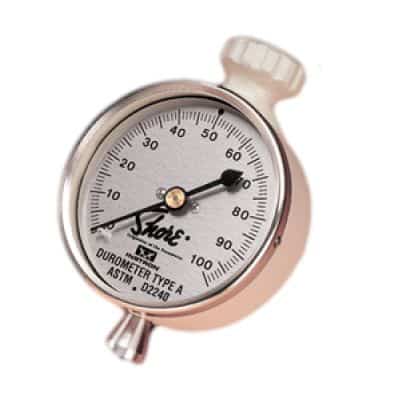What Is Durometer (Shore durometer)?
 The hardness of rubber compounds is measured by the Shore A durometer; the higher the durometer, the harder the compound. 70-durometer hardness should be used whenever possible as it offers the best combination of properties for most O-Rings applications.
The hardness of rubber compounds is measured by the Shore A durometer; the higher the durometer, the harder the compound. 70-durometer hardness should be used whenever possible as it offers the best combination of properties for most O-Rings applications.
Softer compounds stretch easier and seal better on rough surfaces. Harder compounds offer greater abrasion resistance and resistance to extrusion. Extrusion must always be considered where high pressure is used. The proper hardness may be selected from this chart by matching the fluid pressure with the maximum extrusion gap.
60 Shore A is softer than 70
70 Shore A is the standard
90 Shore A is very stiff
The hardness of an elastomer is measured based on the depth of indentation by a standard size and shape impacting gauge. The hardness is obtained by comparing the difference between a small initial force and a much larger final force. The International Rubber Hardness Degrees (IRHD) scale has a range of 0 to 100, corresponding to elastic modulus of 0 (0) and infinite (100), respectively. The measurement is made by indenting a rigid ball into the rubber specimen.
Overview
The Shore A scale is the most prevalent in the United States. The readings range from 30 to 95 points. Harder elastomers use a pointed conical indenter with the Shore D scale. The results of the Shore A scale and the IRHD scale are approximately equal over the same range of resiliency. In elastomers with unusually high rates of stress relaxation or deformation hysteresis, the difference in dwell time in the two readings may cause different results. Also, the results of any hardness test depend on the elastomer thickness. Specified thickness should be used when conducting these tests.
Due to the mechanical limits of the test instruments, hardness measurements of elastomers are rarely expressed more precisely than 5 points.
The surface indentation or hardness usually does not bear any relation to the ability of an elastomeric part to function properly. Hardness is a measure of an elastomer’s response to a small surface stress. Stiffness and compressive modulus measure the response to large stresses of the entire elastomeric part.
Test Methods:
ISO 48(IRHD),
ISO 7619(Shore A)
ASTM D1415(IRHD), D2240(Shore)
A durometer scale is a type of measurement of rubber material hardness. The rubber durometer chart below gives you an idea of the rubber hardness that you want for your application. Generally, most rubber materials fall under the rubber durometer scale of Shore A. Thus, if you need a rubber or O-ring durometer that feels like a running shoe sole, review our rubber hardness chart below, then pick Shore 70A. A rubber durometer of Shore 70A is the most commonly chosen material hardness for all applications.
Shore A Durometer (Hardness) Chart
These values are for the purpose of comparison and understanding in general how Shore A harnesses compare for Elastomers:
25 Durometer = Rubber Band
55 Durometer = Inner Tube
70 Durometer (MOST COMMON) = Rubber Tire/Rubber Shoe Heel
95 Durometer = Shopping Cart Wheel
Global O-Ring offers several devices to test the hardness or durometer of an o-ring.

 English
English  Español
Español  Français
Français  Português
Português  Deutsch
Deutsch  Italiano
Italiano  Русский
Русский  中文
中文  日本語
日本語  العربية
العربية  हिन्दी
हिन्दी